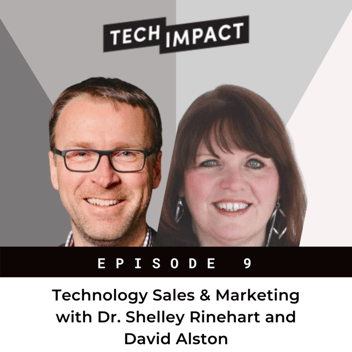EPISODE # 31 The Talent Crunch: Respond and Prepare
TechImpact

Our labour market in Atlantic Canada is changing, and fast!
Along with the way’s pandemic has transformed work, larger economic and demographic shifts are also at play, creating new challenges and opportunities for our region’s tech companies and digital economy businesses.
This episode of TechTalks captures the highlights of a panel discussion hosted by The Canadian Association of Management Consultants-Atlantic Canada Institute in November. TechTalks host and TechImpact CEO Cathy Simpson joined the panel to discuss trends, recent data, and how employers and governments in our region can do to respond to the talent crunch.
The Big Picture
David Chaundy, President and CEO of the Atlantic Provinces Economic Council, kicked things off with a broad look at the economic and demographic trends that are creating this talent crunch.
Even before COVID-19, half of all businesses were experiencing challenges around talent.
“Then, of course, the pandemic struck, and we had a massive disruption to our labour markets in a very short time,” David said, including a huge loss of employment from people working fewer hours or losing their jobs entirely.
The effects were uneven across industries and demographic groups, and that continues. Despite a relatively strong recovery underway, some sectors are still struggling with high job vacancies, and the issue is top of mind for many. In a recent series of webinars APEC hosted, when businesses were asked about the most significant factor holding them back in the next year, over half said labour and skill shortages.
It’s partly due to demographics, including a low birth rate and aging population. David presented a chart showing that the number of young people in our region has halved since 1980, while seniors have doubled. For every ten people retiring, only seven are entering the labour market.
We must attract and–crucially–retain 13,000-16,000 to maintain even modest economic growth.
“And we're just talking about numbers,” he said. “We're not talking about experience and skills and whether they meet requirements.”
Beyond the numbers, the quality of candidates matters. Better market matching and labour market information is essential, as is training and reskilling. And, as our next panellist explores in more detail, attracting workers will mean higher salaries and better compensation.
Along with having more people join the workforce, We also need to improve productivity by investing in new technology and automation.
“This is the new reality,” David said. “This talent crunch is something we're going to have to learn to live with and work with over the next few decades.”
How to Attract & Retain Talent
To dig deeper into what employers should do when there’s so much competition for talent, Michelle Murray, Regional Manager-Halifax for Randstad Technologies, an HR firm, started by sharing current workforce and hiring trends.
The first thing those on the hiring line need to know is that remote work is here to stay. Michelle said that more than half the IT jobs posted for Nova Scotia advertised remote work as an option, in line with national trends.
“For the traditional employers who want employees in the office 100% of the time, more challenges are ahead,” she said.
And while remote work has been something of a boon to our region, opening up the talent pool, competition for candidates has also intensified. Michelle cited a recent survey finding that 57% of workers are open to new opportunities. So what are they looking for?
Salary is the top motivator to change jobs, as only 15% of those surveyed are happy with the current salary. But Michelle urged employers to think beyond pay, to consider their entire compensation package.
“It's important,” she said. “In some cases, it may be difficult to compete directly just on salary alone.”
Social issues and culture are increasingly important to job-seekers, as is flexibility.
“Employees are not looking to be mandated back to work; they want to have flexibility,” she said. “That can be a deciding factor for someone with multiple offers.”
Here are some questions to ask if your company is recruiting:
-
How are you approaching your market? Are you engaging new graduates?
-
What is your diversity and inclusion strategy? How are you attracting more underrepresented groups in IT?
-
How are you engaging with applicants? How long is your hiring process? How many interviews do you require?
-
Do you understand what motivates the talent you seek?
Michelle spoke of the critical need to retentain as well as to attract talent. A few questions to consider:
-
How do you engage your employees today?
-
Do you know what they want?
-
Are you upskilling your current workforce?
-
Have you recently evaluated your compensation packages?
Michelle reminded our audience that these challenges are not unique to our region, that they are national and even international, and everyone is figuring it out.
“We are evolving, we are changing, and it's going to continue this way for quite some time,” she said. “ And employers need to be adaptable and adjust.”
Creating the ‘Atlantic Boom'
I was able to close out the panel by talking about TechImpact’s vision for an “Atlantic Boom” building on our region’s learnings and collaboration from the Atlantic Bubble.
This Atlantic Boom would see our provinces working together to build a more robust ecosystem for talent by investing in business, driving more students into our post-secondary institutions, and attracting and retaining more immigrants.
I firmly believe that our goal is a digitally rich economy and to do that, we need investments, we need productivity improvements, and we absolutely need talent. It is the essential ingredient across our entire economy.
I talked about the kinds of skills we must build not only in students but in employees, including analytics, innovation, active learning and learning strategies, problem-solving, and emotional intelligence.
When we think about the digital economy and that digital is everywhere, we're imagining how automation and machines are working with humans. It's not one against the other, it's that partnership as we look ahead, so the roles are going to be different.”
I was able to share some results from a five-year IT workforce strategy that TechImpact recently conducted. The overarching message from the many companies that were consulted for the strategy is relentless, ongoing change.
The bottom line is the amount of growth that these companies are saying they're going to experience is unprecedented.
The research boiled down to four pillars for a workforce strategy:
-
Workforce supply and demand.
-
Talent acceleration.
-
Talent pipeline development.
-
Recruitment.
From there, the strategy identified nearly 30 projects to tackle over the next five years, including a governance committee, which is not sexy, but necessary.
We're only going to solve this talent problem if we have complete partnership and accountability between academia, private industry and government. It's absolutely crucial.
Other initiatives include promoting the Atlantic Canada brand, “positioning ourselves as the place to live,” building the digital skills of students and educators, and supporting employers and business through digital transformation and reimagining the work they do.
Each one of us needs a plan about what we want to do into the future and the kinds of skills we need. And we have to be dynamic because there is so much change happening.
Check out our entire conversation by clicking here to listen or watch the webinar here.
DON’T MISS AN EPISODE.
Do you subscribe to the Tech Talks With Cathy Simpson podcast? If not, please do. Every week, my guests and I will be covering lots of different topics around innovation, technology and the future. Click here to listen and subscribe in iTunes. You'll find us on Spotify, Apple Podcasts, Google Podcasts, PodLink and everywhere else you enjoy podcasts.
And sign up for our newsletter to never miss an update.
Visit Techimpact's website here
.png?width=600&height=187&name=Untitled%20design%20(2).png)

.png?width=352&name=MicrosoftTeams-image%20(13).png)
